

5A.1 Scope
This section presents the flight plan modules, how they satisfy the scientific objectives, and three flight plans that combine the modules in way we believe will satisfy the scientific objectives. It closes with several potential flight-mission strategies.
5A.2 Modules

Figure 5A.1: Basic Stack Pattern for four flight levels.
Flown Crosswind; Outside turns. x: into page; (circle) out of page.
Objectives
Altitudes: 30 m above highest terrain + 3 to 4 other levels within mixed layer (below the base of the inversion). Short (1-2 minute) run within inversion level.
Approximate Time: (30 km legs for each level below 0.8zi + 50-km leg for 0.8zi ): 33-40 min.
Remarks: Approach from high altitude; mark inversion; legs determined from inversion height (zi): for 4 levels: 0.8zi , 0.5 zi, 0.3zi , 30 m above highest terrain. Usually flown crosswind for optimum flux measurements. Can obtain updated inversion heights from Augusta Operations Base.
5A.2.2: Module 2: STACK PLUS TWO ALONG:
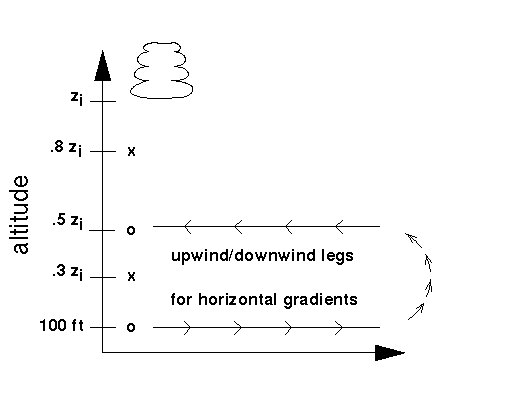
Figure 5A.2: Stack Plus 2 Along. (x): into page;
(o): out of page.
100ft along-wind leg may have to be flown at 500ft agl.
Objectives:
Approximate Time: 30 km legs for each level below 0.8zi + 50-km leg for 0.8 zi; 33-40 in depend on whether 4 or 5 levels; plus 19 minutes for two 50-km along-wind legs.
Remarks: Along-wind legs are zero drift. Normally flown with only one aircraft available.
5A.2.3: Module 3: CAT'S EARS OR MODIFIED VERTICAL RACE TRACK
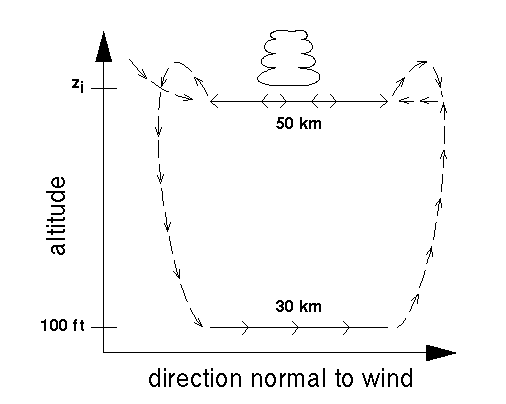
Figure 5A.3: Cat Ear Pattern: One Cycle.
Objective
Altitudes: 30 m above highest terrain (30-km leg) and 60 m below inversion base (50-km leg).
Approximate Time: 40 minutes per cycle.
Remarks: Each cycle includes a pop-up sounding to mark the inversion. In a pop-up sounding, the aircraft just ascends enough to unambiguously penetrate the base of the inversion. The aircraft then returns to the height of the next leg. The sequence following the pop-up:
There is a total of three pop-up soundings and two high-level legs to improve statistics before the aircraft descends for the low-level leg. One cycle thus consists of two inversion-base legs and one log-level leg, with three pop-up soundings for six checks on the inversion height. The third pop-up may be omitted on occasion.

Figure 5A.4: Triangle Pattern The ABLE profilers are marked by an x.
Note the turns are outside turns.
Objectives:
Altitudes: To be flown at 1-3 levels. If three levels are flown, these levels should be at the: lowest practical height, midway between that altitude and the inversion base, and just below inversion base.
Approximate Time: 36 minutes for one complete circuit.
Remarks: This pattern will be the main pattern for wind profiler evaluation. To evaluate budgets, must add a stack to one circuit: a four-leg stack plus 1 circuit would require about 70 minutes. Three patterns could be flown in 4.5 hours.
5A.2.5: Module 5: LENSCHOW MANEUVERS
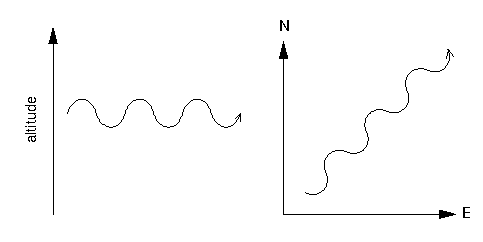
Figure 5A.5 (left) Pitch Maneuver; (right) Sideslip Maneuver.
Objective: Calibrate wind-finding instrumentation.
5A.2.6: Module 6: REVERSE-HEADING MANEUVER
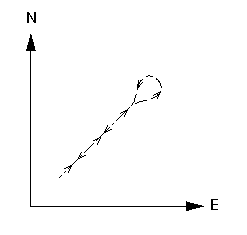
Figure 5A.6. Reverse-Heading Maneuver
Objective: Find true airspeed and sideslip biases.
Procedure: In a region of relatively uniform conditions, reverse heading and return along same track for 2 minutes.
Remarks:
Sufficiently different headings (90 deg or greater) or reverse heading legs at several altitudes over the same spot (as in Stack Patterns) can also yield good results.
This maneuver an excellent technique for calibrating true air speed and side-slip measurements and their effects on the winds.
5A.2.7: Module 7: STEPPED TRUE AIR SPEED MANEUVER
Objective: Check response of instruments at different true airspeeds.
Procedure: This consists of a series of four one-minute segments at one altitude and heading. Pattern should be done above the ABL. Each segment should be flown at a different airspeed. A sample scenario (for the slower airplane):
Remarks: Maneuver should be flown so that the slower aircraft flies at speeds bracketing the faster aircraft's data-collection true air speed, and vice versa.
5A.3: Three 'Optimum' Flight Plans
5A.3.1 Coordinated Flight Patterns: These are flight patterns flown by the King Air and Twin Otter together. Each flight pattern should allow 20 minutes for intercomparison, which is optimally
satisfied on the ferry leg from Ponca City to the Oxford profiler site near Winfield, KS, flown in the mid-boundary layer. If more than one pattern is flown during the day, the aircraft can refuel at Jabara Airport or Augusta Airport.
We anticipate that two flight patterns will be flown by each aircraft during an IOP. The following day will be a 'down' day for flight crews.
5A3.1: Stacks and Triangles: This pattern is designed to be flown in near steady-state conditions. If stacks are replaced with Cat's Ears, it can be flown in rapidly changing conditions. It will produce data for budgets and for comparison of profilers, radiosonde, and aircraft data.
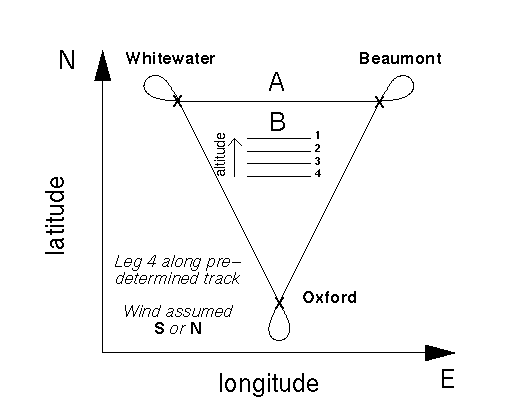
Figure 5A.7: Stacks and Triangles
In this pattern, Aircraft A flies the Triangle Pattern (Module 6) at three altitudes, while Aircraft B flies the basic stack pattern (Module 2) repeatedly. Inversion height should be checked by B during top-level leg.
Option 1: Aircraft A reverses heading after each circuit.
Option 2: Replace stack with Cat's Ears for rapidly-changing conditions.
Duration: ~4.5 hours.
5A3.2 Mixed Cat's Ears and Stack. This pattern is designed for rapidly changing conditions. The Cat's Ears concentrates sampling just below zi, where change is most rapid and assumes that vertical fluxes vary linearly with height. The stack patterns check that assumption. The aircraft land at Jabara or Augusta to refuel and rest before the pattern is flown again in the late afternoon (evening collapse) before returning to Ponca City.

Figure 5A.8: Mixed Cat's Ears and Stack.
Aircraft can alternate positions to minimize bias or system-failure problems.
Procedure: The steps are parallel to that of the double stack pattern (5A3.1).
After ferry north from Ponca City, Aircraft A commences Cat's Ears pattern at southern position, while Aircraft B progresses northward to start multilevel stacks (at least four levels). B has the option of not doing legs in exact order. For example, they could follow the sequence: highest, 2nd lowest, then 2nd highest, then lowest. Aircraft change positions after about 2 hours.
Duration: ~4 hours.
5A3.4: Single-Aircraft Sequential Flight Patterns:
These flight patterns are designed to insure data for the entire day, from sunrise to sunset. The Stack pattern will be flown for near-steady state conditions, and the mixed Stack/Cat's Ears patterns will be flown for more rapidly changing zi. Expectations are rapid change of zi in the morning, steady state from ~1100-2500 LST, and unknown behavior of zi associated with the ‘collapse’ of the convective boundary layer in the afternoon. This behavior implies that we must pay close attention to zi 's measured at the profiler/radiosonde sites. One possible scenario (Jabara airport is used here for convenience; the pilots may find another more desirable):
(1) Sunrise-1 hour: Aircraft A takes off from Ponca City, and then commences Cat's Ear's pattern in the center of the array. After roughly three patterns, aircraft A will circumnavigate the array in a Triangle Pattern. Aircraft A finishes with a second set of Cat's Ears, and land at Col. Jabara to rest and refuel for second takeoff in four hours.
(2) 4 Hours after (1): Aircraft B takes off from Ponca City, and then commences Cat's Ears or stack pattern depending on BL growth. After roughly 1.7 hours (3 sets?) B circumnavigates the area in a Triangle at mid BL level; and then finishes with a second set of flux profiles. This would be the best time for an intercomparison just after A takes off from Jabara for its second set of patterns. B lands at Jabara and refuel for second takeoff in 4 hours.
(3) After intercomparison, Aircraft A performs sequence of Stack/Cat's Ears, Triangle, and Stack/Cat's Ears as in (2). A completes pattern with intercomparison by meeting B after it takes off from Jabara. A then ferries home to Ponca City at mid-BL height along track that is as close to along wind as reasonable (e.g. proceed to due north of Ponca for north or south wind).
(4) After intercomparison, Aircraft B performs sequence of Stack/Cat's Ears, Triangle, and Stack/Cat's Ears as in (2). Cat’s Ears are more likely to be flown here. When complete, B will proceed to Ponca City at mid-BL along track as close to along wind as reasonable.
Variant: Aircraft could fly more triangles and fewer stacks. This might be considered particularly for midafternoon, when conditions are more steady.
Table 5.4: Advantages of the 'Optimum' Flight Patterns (Note: The patterns are subject to modification.)
|
Flight Patterns |
Benefits |
|
Mixed Cat's Ears and Stack; |
Budget (good) Diurnal (fair) Compare with 2 of three profilers Aircraft compare on Oxford-Ponca ferry Good for mainly crosswind heterogeneity |
|
Stacks and Triangles |
Budget (excellent) Diurnal (fair) Compare with all three profilers Aircraft compare on Oxford-Ponca ferry |
|
Single-Aircraft in Sequence |
Budget (Fair to Good) Diurnal (excellent) Compare with 3 profilers but at one level Aircraft comparisons more difficult but possible Hetererogeneity fair to good |
a Ferry is from Ponca City to Oxford profiler, within the PBL. Offers opportunity for aircraft comparison as well as comparison with profiler. Should be flown beyond profiler above 1 min.
 Move to Operations Plan home page
Move to Operations Plan home page
